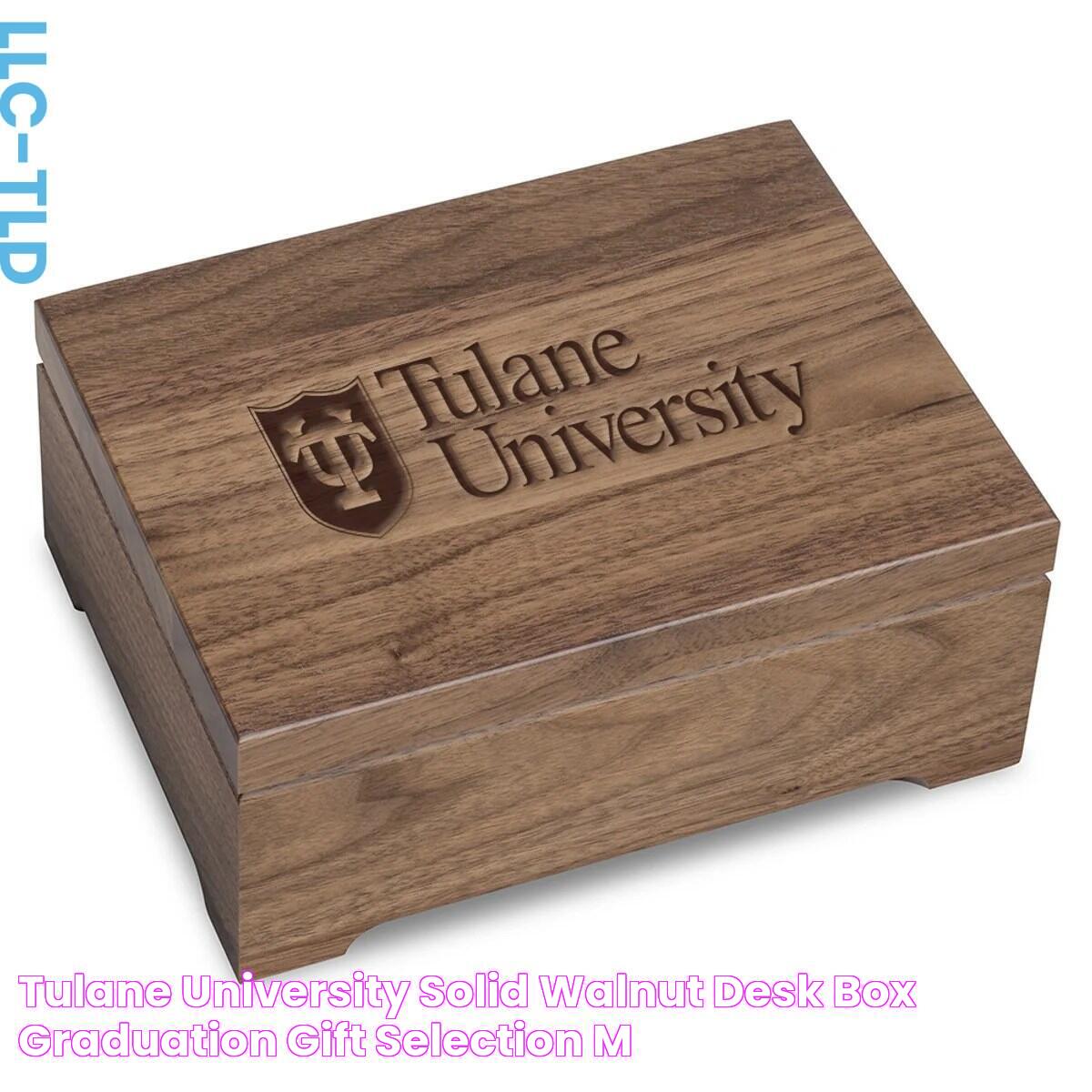Tulane Box: Uncover The Secrets Of New Orleans' Underground History
The Tulane Box is a collection of cranial capacity measurements of human skulls from different populations around the world. Compiled by Tulane University researchers, the box is an invaluable tool for anthropologists, biologists, and other scientists studying human evolution and variation.
The importance of the Tulane Box lies in its comprehensive nature, providing a detailed record of skull capacities from diverse populations. This data has been instrumental in understanding the evolution of brain size and shape, as well as providing insights into population relationships and migrations. Historically, the Tulane Box has played a significant role in shaping our understanding of human diversity and has been referenced in numerous scientific publications and textbooks.
Moving forward, the Tulane Box will continue to be a valuable resource for researchers seeking to explore the intricacies of human evolution and the factors that have shaped our species over time. Its comprehensive data and historical significance make it a cornerstone of anthropological research and a testament to the ongoing pursuit of knowledge about our origins and diversity.
Read also:Unbelievable Discover The Riches Of Ed Kelce Net Worth Unveiled
Tulane Box
The Tulane Box, a collection of cranial capacity measurements, holds immense significance in the study of human evolution and diversity. Six key aspects that underscore its importance are:
- Comprehensive Data: Encompassing skull capacities from diverse populations worldwide.
- Evolutionary Insights: Provides a record of brain size and shape evolution.
- Population Relationships: Offers insights into population connections and migrations.
- Historical Significance: A cornerstone of anthropological research since its compilation.
- Educational Value: Used in textbooks and scientific publications to illustrate human diversity.
- Ongoing Research: A valuable resource for ongoing studies in human evolution.
In conclusion, the Tulane Box is a comprehensive collection that has played a pivotal role in advancing our understanding of human evolution. Its data has been instrumental in uncovering population relationships, studying brain evolution, and shaping our knowledge of human diversity. The ongoing use of the Tulane Box in research and education ensures its continued relevance in the pursuit of knowledge about our origins and the factors that have shaped our species over time.
1. Comprehensive Data
The Tulane Box's comprehensive data, encompassing skull capacities from diverse populations worldwide, is a cornerstone of its significance. The vast and varied nature of the data provides a unique opportunity to study human evolution and variation across different populations. By comparing skull capacities from different regions and time periods, researchers can gain insights into the evolutionary forces that have shaped human brain size and shape.
For instance, studies utilizing the Tulane Box have shown that there is a general trend towards an increase in brain size over time, particularly in the last 2 million years. This observation has implications for understanding the evolution of cognitive abilities and the development of complex behaviors in humans. Additionally, the data has been used to explore population relationships and migrations, as skull capacity can vary significantly between different populations.
In conclusion, the comprehensive data in the Tulane Box is essential for studying human evolution and diversity. It provides a valuable resource for researchers seeking to understand the factors that have shaped our species over time and continues to contribute to our knowledge of human origins and variation.
2. Evolutionary Insights
The Tulane Box offers invaluable insights into the evolution of brain size and shape. This data has been instrumental in shaping our understanding of human cognitive development and the factors that have influenced the evolution of our species.
Read also:Indulge In The Distinct Flavor Discover The Unique Taste Of Target Keyword
- Comparative Analysis: By comparing skull capacities from different populations and time periods, researchers can identify trends and patterns in brain size evolution. This comparative approach has revealed a general increase in brain size over time, particularly within the last 2 million years.
- Population Variation: The Tulane Box highlights the significant variation in skull capacity between different populations. This variation provides insights into the genetic and environmental factors that influence brain size and shape, contributing to our understanding of human diversity.
- Adaptive Significance: Researchers can explore the adaptive significance of brain size and shape variation by examining the relationship between skull capacity and environmental factors, such as diet, climate, and social organization. This line of inquiry sheds light on how evolutionary pressures have shaped human cognition and behavior.
- Extinct Hominin Species: The Tulane Box also includes data on extinct hominin species, such as Neanderthals and Homo erectus. By comparing the skull capacities of these species to modern humans, researchers can gain insights into the evolutionary relationships between different hominin groups and the factors that contributed to their divergence.
In conclusion, the Tulane Box provides a wealth of data that has revolutionized our understanding of brain size and shape evolution. The insights gained from this collection have shaped our knowledge of human origins, diversity, and cognitive development, and continue to inform ongoing research in the field of human evolution.
3. Population Relationships
The Tulane Box offers valuable insights into population relationships and migrations by providing a comprehensive record of skull capacities from diverse populations worldwide. This data enables researchers to study the genetic and environmental factors that have influenced the variation in brain size and shape across different populations.
- Comparative Analysis: By comparing skull capacities from different populations, researchers can identify patterns and trends in brain size variation. This comparative approach has revealed significant differences between populations, providing clues about their genetic relationships and migratory history.
- Population Genetics: The Tulane Box data can be integrated with genetic information to explore the relationship between brain size and specific genetic variants. This line of inquiry helps identify the genetic basis of brain size variation and its potential role in population differentiation.
- Paleoanthropology: The inclusion of extinct hominin species in the Tulane Box allows researchers to examine the evolutionary relationships between different hominin groups. By comparing the skull capacities of modern humans with extinct species, scientists can gain insights into the factors that contributed to the divergence and migration of hominin populations.
- Environmental Factors: The Tulane Box data can be analyzed in conjunction with environmental variables, such as climate, diet, and social organization, to explore the influence of environmental factors on brain size variation. This approach sheds light on the adaptive significance of brain size and shape in different environments.
In conclusion, the Tulane Box provides a wealth of data that has revolutionized our understanding of population relationships and migrations. By studying the variation in skull capacities across different populations and time periods, researchers have gained valuable insights into the genetic, environmental, and evolutionary factors that have shaped human diversity.
4. Historical Significance
The historical significance of the Tulane Box as a cornerstone of anthropological research cannot be overstated. Since its compilation, the box has played a pivotal role in advancing our understanding of human evolution and diversity, establishing itself as an indispensable tool for anthropologists and other scientists.
The Tulane Box has served as a foundational resource for numerous scientific publications and textbooks, shaping the way we think about human origins and variation. Its comprehensive data has enabled researchers to explore a wide range of topics, including the evolution of brain size and shape, population relationships, and migrations. The box's historical significance lies in its role as a catalyst for groundbreaking discoveries that have transformed our understanding of the human story.
One of the key reasons for the Tulane Box's enduring importance is its role in fostering collaboration and knowledge-sharing among researchers. By providing a centralized repository of cranial capacity measurements, the box has facilitated the exchange of ideas and data, leading to a more comprehensive understanding of human evolution. Additionally, the box's historical significance extends to its educational value, as it has been used to teach generations of students about human diversity and the processes that have shaped our species over time.
In conclusion, the historical significance of the Tulane Box as a cornerstone of anthropological research is undeniable. Its comprehensive data, role in groundbreaking discoveries, and educational value have made it an indispensable resource for understanding human evolution and diversity. The box continues to be a vital tool for researchers and educators alike, ensuring its enduring legacy in the field of anthropology.
5. Educational Value
The Tulane Box has immense educational value as it serves as a valuable resource for textbooks and scientific publications seeking to illustrate human diversity. Its comprehensive data on cranial capacity measurements from diverse populations provides a rich foundation for educational materials.
- Illustrating Evolutionary Trends: The Tulane Box data can be used to illustrate evolutionary trends in brain size and shape over time. By examining the changes in skull capacities across different populations and time periods, educators and researchers can demonstrate the dynamic nature of human evolution.
- Highlighting Population Variation: The box also highlights the significant variation in skull capacity between different populations, emphasizing the diversity that exists within our species. This variation can be attributed to a range of factors, including genetic, environmental, and cultural influences.
- Teaching Comparative Anatomy: The Tulane Box data can be used to teach comparative anatomy, allowing students to compare the skull capacities of different hominin species, such as modern humans, Neanderthals, and Homo erectus. This comparative approach helps students understand the evolutionary relationships between different hominin groups.
- Promoting Critical Thinking: By using the Tulane Box data, educators can encourage students to develop critical thinking skills. Students can analyze the data, draw inferences, and formulate hypotheses about the factors that have shaped human brain size and diversity.
In conclusion, the Tulane Box is an invaluable educational resource that enhances our understanding of human diversity and evolution. Its data provides a concrete foundation for teaching and learning about the complexities of our species, fostering a deeper appreciation for the diversity that makes us human.
6. Ongoing Research
The Tulane Box, with its comprehensive data on cranial capacity measurements, plays a crucial role in ongoing research in human evolution. It serves as a valuable resource for scientists exploring various aspects of our evolutionary history.
- Understanding Evolutionary Trends: The Tulane Box enables researchers to study long-term trends in brain size and shape evolution. By analyzing changes in skull capacities over time, scientists can gain insights into the selective pressures that have influenced the development of the human brain.
- Exploring Population Relationships: The data in the Tulane Box helps researchers investigate population relationships and migrations. By comparing skull capacities across different populations, scientists can infer genetic connections and dispersal patterns, shedding light on human evolutionary history.
- Investigating Environmental Influences: The Tulane Box can be used to examine the impact of environmental factors on brain size and shape. Researchers can correlate skull capacity data with environmental variables, such as climate, diet, and social organization, to understand how these factors have influenced human evolution.
- Comparative Analysis: The Tulane Box facilitates comparative analyses between modern humans and extinct hominin species. By comparing skull capacities, researchers can gain insights into the evolutionary relationships between different hominin groups and the factors that contributed to their divergence.
In conclusion, the Tulane Box is an invaluable resource for ongoing research in human evolution. Its comprehensive data and historical significance continue to inform our understanding of brain size and shape evolution, population relationships, and the interplay between genetics, environment, and human evolution.
FAQs about the Tulane Box
The Tulane Box, a collection of cranial capacity measurements, is a significant resource for understanding human evolution and diversity. Here are answers to some frequently asked questions about the Tulane Box:
Question 1: What is the Tulane Box?
The Tulane Box is a collection of cranial capacity measurements of human skulls from different populations around the world, compiled by researchers at Tulane University.
Question 2: What is the significance of the Tulane Box?
The Tulane Box is significant because it provides a comprehensive and historical record of skull capacities from diverse populations, enabling researchers to study human evolution and variation.
Question 3: How is the Tulane Box used in research?
The Tulane Box is used in research to study evolutionary trends, population relationships, environmental influences, and comparative analyses between modern humans and extinct hominin species.
Question 4: What are the limitations of the Tulane Box?
One limitation of the Tulane Box is that it does not include data on other aspects of brain anatomy, such as brain shape or regional variation within the brain.
Question 5: How can I access the Tulane Box data?
The Tulane Box data is available upon request from the researchers at Tulane University who compiled it.
Question 6: What are the ethical considerations related to the Tulane Box?
The Tulane Box data is collected from human remains, so researchers must adhere to ethical guidelines and respect the cultural and historical sensitivities surrounding the use of human remains in research.
Summary: The Tulane Box is a valuable resource for studying human evolution and diversity. Its comprehensive data and historical significance continue to inform our understanding of brain size and shape evolution, population relationships, and the interplay between genetics, environment, and human evolution.
Transition: For further exploration, the next section delves into the methodologies and techniques used in studying the Tulane Box data.
Tips for Utilizing the Tulane Box in Research
The Tulane Box is a valuable resource for studying human evolution and diversity. Here are some tips to optimize its use in research:
Tip 1: Define Clear Research ObjectivesClearly define your research objectives before using the Tulane Box data. This will guide your data selection and analysis, ensuring that you collect and examine relevant information.
Tip 2: Select Appropriate DataThe Tulane Box contains a vast amount of data. Choose the data that is most relevant to your research question. Consider factors such as population, time period, and sample size.
Tip 3: Use Appropriate Statistical MethodsEmploy appropriate statistical methods to analyze the Tulane Box data. Consider the type of data you have, the research question, and the desired level of statistical significance.
Tip 4: Consider Potential BiasesBe aware of potential biases in the Tulane Box data. These biases may arise from sampling methods, measurement techniques, or historical factors. Address these biases in your analysis and interpretation.
Tip 5: Integrate Multiple Sources of EvidenceCombine the Tulane Box data with other sources of evidence, such as genetic data, archaeological findings, or paleoenvironmental data. This triangulation of evidence strengthens your research conclusions.
Summary: By following these tips, researchers can effectively utilize the Tulane Box to gain valuable insights into human evolution and diversity. The Tulane Box, combined with appropriate methodologies and critical analysis, provides a powerful tool for advancing our understanding of the human story.
Transition: The following section explores the broader implications of the Tulane Box for understanding human evolution and the future directions of research.
The Tulane Box
The Tulane Box, a collection of cranial capacity measurements from diverse human populations, has played a pivotal role in advancing our understanding of human evolution and diversity. Its comprehensive data and historical significance have made it an indispensable resource for researchers seeking to explore the intricacies of our evolutionary history.
Through the study of the Tulane Box, we have gained valuable insights into the evolution of brain size and shape, the relationships between different populations, and the impact of environmental factors on human evolution. It has served as a cornerstone for groundbreaking discoveries and continues to inspire ongoing research, contributing to our ever-deepening understanding of the human story.
Life360: Your Comprehensive Family GPS Tracker
He Said, She Said: Freddy Moore And Renee Moore
Know The Meaning Of Chama Pereira Now


